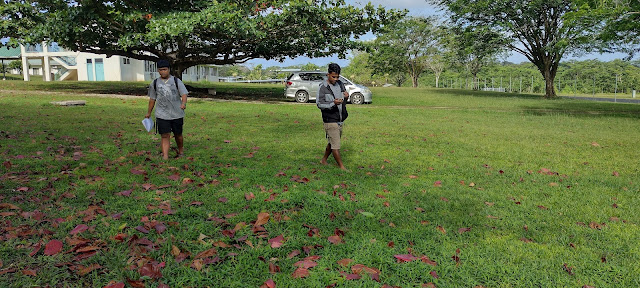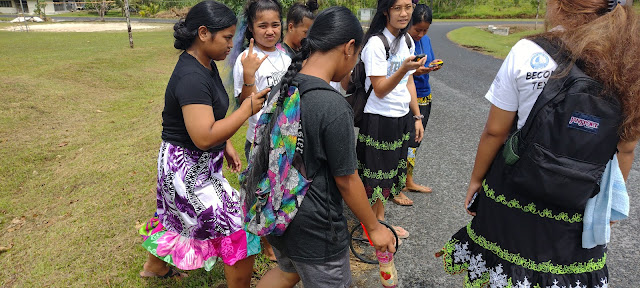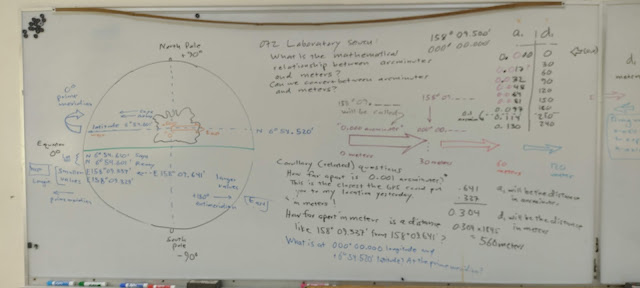Laboratory seven seeks to determine the conversion factor from arcminutes to meters. This exercise leads to answering a question posed in yesterday's hide and seek exercise: how close to my hide can commercial GPS coordinates put one?
Jessie Mae, Jasmine, Adelina
In the 8:00 session I began as in the past at N 06° 54.570' E 158° 09.600'. The section then walked 30 meters due east.
Renay
The first stop was at 30 meters, which is 0.016 ± 0.002 arcminutes east of the starting point. The measuring wheel is not metric, a conversion table provides feet to meters conversions.
Cyron and Richard just beyond the 90 meter mark
Darla recording data out around 120 meters
591 feet, 180 meters, the 2000 is spurious. The wheel started at 2000.
Darla with the college sign
The new fence will curtail moving out to 0.100 arcminutes as the fence is at 0.098 arcminutes
Cyron coming up through the future fence line
Jasmine at 0.100 arcminutes just beyond the future fence location
This is considered to be the last term for the E 158° 09.600' starting point due to the fence. The fence will impact many of the activities I engage in with classes across the campus.
Malikia works on zeroing the measuring wheel in the 11:00 section
As 11:00 I had only the vague notion of moving the start to the west, perhaps near the cultural huts. An exploration with Google Earth suggested that a line through the cultural huts starting near the ChuuChok hut might work. When I reached the hut I realized that the subtraction would be confusing. I also saw that we were not all that far from E 158° 09.500', so I kept walking west.
Blossom watches as Saya checks her GPS near the bookstore
E 158° 09.500' was almost at the bookstore. The latitude, however, was up around N 6° 54.582' This was north of N 6° 54.570' start and I thought that might be problematic further east. The line could intersect the fence ahead of 180 meters. I knew that N 6° 54.570' would clear the B classroom building, so I moved south to N 6° 54.578' which put the class on the sidewalk. I thought for a moment that segment of sidewalk might be east west, but the sidewalk is not. The sidewalk runs from slightly north of west to slightly south of east. WNW to ESE.
The new starting position: N 6° 54.578', E 158° 09.500'
Malika and Leipolanda at the new starting location
Bethlyanne, Saya, and Mellyann take readings at 30 meters
Walking east from N 6° 54.578', E 158° 09.500' required using the GPS units to remain on N 6° 54.578' while Malika pushed the measuring wheel. 30 meters (98 feet) put the class on the edge of the driveway. The class was just to the north of the sidewalk at this point.
Rose Anne, Bethlyanne, Malika, Donnalynn at the 60 meter mark.
Here one can more clearly see that the sidewalk in the background does not point east: the class has moved due East on the N 6° 54.578' line.
This Terminalia catappa is at roughly N 6° 54.577' allowing the class to just edge past on the north side
The class at 60 meters
At 120 meters the N 6° 54.578' line passed between the Pohnpei and Kosrae cultural hut
Data coming in on the route
The class headed to the 150 meter mark
Leipolanda and Donnalynn at 150 meters
This photo at 150 meters gives a sense of the location on the line, BLSon has joined the class at this point
180 meters occurred just across the driveway.
In the past I have run out of space at 180 meters and have only had room enough to have the students walk forward to the 0.100' mark. That seemed unnecessary on this new route, so I took the class on out to 210 meters (689 feet). The
conversion table was later adjusted to accommodate this change.
210 meters, Donnalynn, Leipolanda, Saya, and Mellyann taking readings and recording data into Desmos directly
Malika adjusting her position back to the north
240 meters would be the final measurement
The board at the end of class
On the far left I opened with a review of Monday, recast into the context of the upcoming laboratory session.
Data from the 8:00 section was left posted for the 11:00 class to see. There does appear to be a curiously consistent difference in the slope between 8:00 and 11:00 with the 8:00 slopes all being smaller than the 11:00 slopes.
The new start location worked better than expected. The line missed a tree, threaded between two huts, and just barely kept the class out of the road. Twice. Note that 270 meters might not be possible, that line is headed into the fence just beyond the 240 meter mark. One other post-script: the sun can be hot and health issues or other conditions should be taken into account.
In the past I have then taken the data and either calculated the circumference of the earth (for example 1845 m/arcmin × 60 arcmin/degree × 360 degrees) or run an error analysis against the expected conversion factor for seven degrees north latitude. This term I dropped both to focus on the mathematical relationship as a conversion factor. The only add on material was the calculation of the smallest possible resolution in meters based on a distance of 0.001 arcminutes. I also covered the answer to the question from the day before, what is at E 0° 00.000' and N 6° 54.578' This simplified the content and kept the focus on the conversion factor, something that is confusing enough in and of itself.
I suspect science instructors tend to overestimate what a student actually understands after contact with a course. In the past a number of studies have shown that when faced with novel systems, students who have had the science necessary to correctly explain the novel phenomenon still fall back on previously held misconceptions. The new knowledge does not replace the earlier incorrect understanding, the new knowledge coexists with the earlier misconceptions. One might wonder how a person can reconcile what are often contradictory explanations, how a person can hold contradictory views. But people are especially adept at holding contradictory points of view, contradictory understandings. Our mental processes have no "consistency checking" system that autocorrects conflicting information or understandings.
Over the years I have, if anything, simplified the laboratories in this course because the focus is on science as a process, not a collection of facts to be memorized and accepted on faith. Science is based in experiments and the testing of hypotheses out of which, to borrow a phrase from Neil de Grasse Tyson, an emergent truth arises. I used to approach the course from the "science is that which can be proven false, therefore nothing is actually ever proven to be true" position. This is the position that frequentist statistical testing enforces. Nothing is ever true, it is either shown to be false or shown that we are unable to show that it is false. We either reject the null hypothesis or we fail to reject the null hypothesis. But we never accept anything. Nothing is ever actually true. With age, however, I find that position to be unnecessarily weak. There are scientific truths that emerge from experiments. Gravity has a measurable acceleration. That value is an emergent truth.
The textbook too follows this path: science as a series of laboratory encounters, data that drives mathematical models out of which a truth evolves. Not "a thousand facts in sixteen weeks." Down that path lies the crazy world of antiscience seen today: the "I don't believe..." as if science is an act of faith. Which it was for too many students in schools with massive textbooks, colorful, pushed by publishers, with more content each and every year. Content that no instructor ever actually finishes. "Read and regurgitate chapter five..." is not science. So this class focuses on doing, measuring, and finding emergent truths.
































Comments
Post a Comment